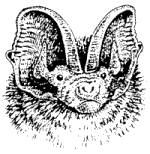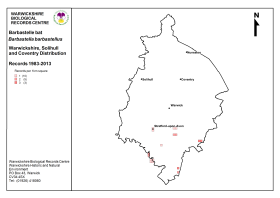Barbastelle
 The Barbastelle (Barbastella barbastellus) is a very elusive bat
with very few records from Britain each year. It is recorded from a wide
area of southern Britain though it is very unpredictable in its occurrence
and only 4 breeding colonies are known in the UK. It is also found in most
of western Europe (excluding Scotland, Ireland and most of Scandinavia).
The Barbastelle (Barbastella barbastellus) is a very elusive bat
with very few records from Britain each year. It is recorded from a wide
area of southern Britain though it is very unpredictable in its occurrence
and only 4 breeding colonies are known in the UK. It is also found in most
of western Europe (excluding Scotland, Ireland and most of Scandinavia).

Distribution map for Barbastelle bats in Warwickshire. (Click for a full sized image)
It is a medium-sized species with blackish fur on the back and the tips of
the hairs may be pale cream or yellow, giving a frosted appearance. The underfur
is grey-brown, often with pale tips. The ears are black, short and broad and
joined across the forehead and with its rather squat face this gives it a very
distinctive "pug-like" appearance.
Barbastelle bats are vulnerable to the decline of woodland, which results in the loss of suitable feeding habitats
and hollow trees for roosting. They are susceptible to pesticides, especially
those used as remedial timber treatment chemicals. Disturbance and vandalism of
their hibernating sites, caves and tunnels, is an additional threat.
flight & ultrasound
Barbastelle bats emerge in early dusk and hunt low over water and at
tree top height along woodland edges and gardens. They fly fast and skilfully,
using a two-part call. The 43 kHz call is generally weak and often inaudible or absent.
However, the main call is much louder and is lower in frequency, with
a peak frequency around 32kHz. It is said to resemble a sort of "wood-block"
sound. Their calls are very quiet being up to 100 times quieter than
other aerial hawking bats which allows them to specialise in hunting for
moths that can hear other bat species' calls. The downside of using these
weaker calls is that they are unable to "see" as well as those bats
emitting stronger calls.
 Barbastelle call on a Heterodyne bat detector
Barbastelle call on a Heterodyne bat detector
 Barbastelle call on a Time Expansion bat detector
Barbastelle call on a Time Expansion bat detector
breeding
In summer females segregate and form small maternity colonies; males
usually remain solitary or in small groups. The females are sexually mature
in their second year. Barbastelle bats are very sensitive to disturbance.
summer roosts
 Roosts are mostly in hollow trees and buildings. Other recorded roost
sites include under tree bark and amongst exposed tree roots.
Roosts are mostly in hollow trees and buildings. Other recorded roost
sites include under tree bark and amongst exposed tree roots.
winter roosts
In winter they occasionally appear close to the entrances of caves during
prolonged cold spells. As they are a cold-resistant species, this suggests
that they are not dependent on such underground sites but make use of
them in periods of particularly cold weather. Winter groups are commonly
of mixed-sex.
| Description |
|
| Head and Body Length |
45 - 58 mm |
| Forearm Length |
36 - 44 mm |
| Wingspan |
260 - 290 mm |
| Weight |
6 - 13 g |
| Colour |
Fur is blackish on the back and the tips of the hairs
may be pale cream or yellow, giving a frosted appearance. Squat face
gives a very distinctive 'pug-like' appearance. |
| |
|
| Life Cycle |
|
| Mating Period |
Autumn and winter. |
| Maternity Colonies |
Young: 1 born mid-June. |
| Colony Size |
10 - 20 females, rarely up to 100. |
| Longevity |
23 years. |
| UK Status |
Rare. |
| |
|
| Habitat and Food |
|
| Summer Roosts |
Hollow trees and buildings. |
| Winter Roosts |
Caves, tunnels, trees. |
| Feeding Habitat |
Wooded river valleys, over water and woodland edges. |
| Food |
Lepidoptera,
diptera,
small beetles. They have a weak jaw and so are unable to bite
through the shells of large beetles. |
further reading
'An aerial-hawking bat uses stealth echolocation to counter moth
hearing' by Holger R. Goerlitz, Hannah M. ter Hofstede, Matt R. K. Zeale,
Gareth Jones, Marc W. Holderied (Current Biology) (web page,
510Kb)
Detailed species notes on the Barbastelle by Jens Rydell & Wieslaw
Bogdanowicz (American Society of Mammalogists, 1997) (pdf,
988Kb)